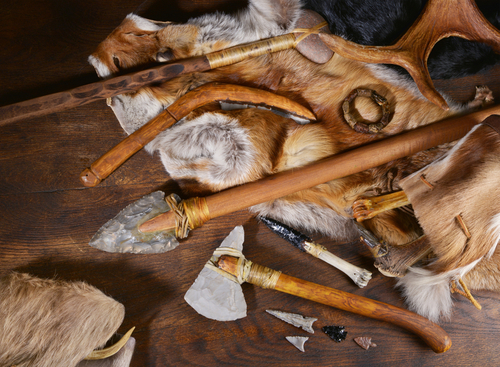The Paleolithic Period, often referred to as the Stone Age, is a critical chapter in human history characterized by the use of stone tools.
This prehistoric era is divided into three main phases:
- Lower Paleolithic
- Middle Paleolithic
- Upper Paleolithic
Each phase brought significant changes in tool technology, the emergence of different hominin species, and the development of more complex social structures.
Over millions of years, humans evolved from using simple stone tools to crafting finely detailed blades and creating intricate art.
This period ultimately laid the foundation for the cultural and technological advancements that would follow in human history.
| Paleolithic Period | Time Frame | Key Developments and Features |
|---|---|---|
| Lower Paleolithic | 2.6 million years ago – 200,000 years ago | – Early Stone Age – Use of simple tools such as choppers and handaxes – Presence of Homo habilis and Homo erectus – Possible controlled use of fire at the end of this phase |
| Middle Paleolithic | 200,000 years ago – 40,000 years ago | – Development of more advanced stone tools, including blades and points – Emergence of Homo neanderthalensis (Neanderthals) – Evidence of complex social structures and possible burial rituals – Increased control over fire and use of caves for shelter |
| Upper Paleolithic | 40,000 years ago – 10,000 years ago | – Late Stone Age – Remarkable advances in tool technology, including finely crafted blades and specialized tools – Appearance of anatomically modern humans (Homo sapiens) – Elaborate art and symbolism, such as cave paintings and jewelry – Development of complex social structures and possible emergence of early forms of language – Cultural innovations like clothing and improved hunting techniques |
Timeline of the Paleolithic Period
Lower Paleolithic (2.6 million – 200,000 years ago):
Early Stone Age: The Lower Paleolithic marks the earliest phase of human prehistory. During this time, our ancestors primarily used simple stone tools, often referred to as “Oldowan tools.” These tools included choppers and handaxes, which were used for cutting, chopping, and butchering.
Homo habilis and Homo erectus: Hominin species like Homo habilis and Homo erectus lived during the Lower Paleolithic. They were characterized by their bipedalism (walking on two legs) and the use of these primitive stone tools. Homo erectus, in particular, is known for its wider distribution and adaptability.
Also Read: Facts About the Paleolithic Age
Possible Controlled Use of Fire: Towards the end of the Lower Paleolithic, there is evidence to suggest that early humans began to gain some control over fire. Fire provided warmth, protection from predators, and the ability to cook food, which could have had significant impacts on their diet and survival.

Middle Paleolithic (200,000 – 40,000 years ago):
More Advanced Stone Tools: The Middle Paleolithic saw significant advancements in tool technology. Stone tools became more refined and included blades and points. These improvements in toolmaking allowed for more efficient hunting, butchering, and other activities.
Emergence of Neanderthals: During this period, Neanderthals (Homo neanderthalensis) appeared in Europe and parts of Asia. They had a robust physique and are believed to have had complex social structures, including care for the injured and elderly members of their communities.
Also Read: Mesolithic Age Facts
Complex Social Structures and Possible Burial Rituals: Archaeological evidence suggests that Middle Paleolithic humans had increasingly complex social structures. There are also indications of ritualistic burials, possibly reflecting early spiritual or cultural practices.
Improved Control of Fire and Shelter Use: Humans in the Middle Paleolithic continued to refine their control over fire, using it for warmth, cooking, and protection. They also began to use caves and other natural shelters more systematically.

Upper Paleolithic (40,000 – 10,000 years ago):
Late Stone Age: The Upper Paleolithic is often referred to as the Late Stone Age due to the advanced tool technology that characterized this period. Humans made finely crafted blades and specialized tools for various purposes.
Appearance of Anatomically Modern Humans: Anatomically modern humans (Homo sapiens) emerged during the Upper Paleolithic. They had the same physical characteristics as modern humans and displayed increased cognitive abilities.
Elaborate Art and Symbolism: This period is known for its rich artistic expression. Humans created intricate cave paintings, carvings, and personal adornments like jewelry. These artworks reflect a growing capacity for symbolic thinking.
Complex Social Structures and Cultural Innovations: The Upper Paleolithic saw the development of more complex social structures, possibly with the emergence of early forms of language. Cultural innovations included the creation of clothing for protection and the refinement of hunting techniques, leading to greater efficiency in obtaining food.
